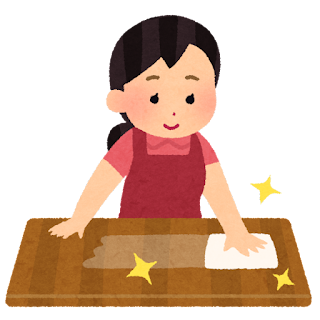Childcare|CHCECE002 #3 - Implement effective hygiene and health practices (part 2)
學習筆記 Note Childcare
CHCECE002
Ensure the health and safety of children
#3 - Implement effective hygiene and health practices
(part 2)
 |
| 來源:いらすとや |
.consistently implement hygiene practices that reflect advice from relevant health authorities
.support children to learn personal hygiene practices
.implement the service health and hygiene policy and procedures consistently
.ensure service cleanliness is consistently maintained
.observe and respond to signs of illness and injury in children
.systematically record and share this information with families
.consistently implement the service policies for the exclusion of ill children
.discuss health and hygiene issues with children
# Health and safety policies and procedures
.cover all areas of service
.include regular maintenance & cleaning schedules
.assign tasks with different staff & rotate regularly
.review annually & ensure no areas are missed
# Personal protective equipment (PPE)
.include disposable gloves, apron, mask, goggles, plastic bootees
.cover all open wounds (grazes, abrasions) with full band aid
.serious risk of contamination → seek relevant health authorities & professional cleaners
# Appropriate use of gloves (from Staying Healthy 5th Edition)
.not replace with hand washing
.perform hand hygiene before & after using gloves
.contact with body fluids (faeces, urine, saliva, vomit, blood) → wear gloves
.disposable gloves → not re-useable, throw away sensibly after use
.preferable latex powder-free (latex allergies → nitrile gloves)
 |
| resource: Staying Healthy 5th Edition |
# How to remove disposable gloves (from Staying Healthy 5th Edition)
 |
| resource: Staying Healthy 5th Edition |
# Wash hands
.prevent spread of infection & maintain hygiene
.hand washing procedure → display in relevant areas of the service + implement
.wash hands before & after
> nappy change
> toilet
> eating / handling food
> handling animals
> blow nose / sneeze
> performing first aid
> touch child's hair
> play outside
# How to wash hands
1. wet hands
2. apply soap
3. rub hands 15s
4. wash wrists, back of hands, between fingers, under fingernails
5. rinse hands 10s
6. turn off tap with paper towel & discard
7. dry hands with another paper towel
# Involve children in good hygiene
.demonstrate & modelling good personal hygiene
.encourage children to become independent
.speak & discuss with children about health and hygiene issues (watch videos, read stories, create talking tables, ask questions)
.invite dentist to the service → learn about dental care + oral health
.send newsletter
.display photos & posters
# Illness and injury
.illness: come from a multitude of origins, can pass from person to person (infectious)
.injury: happen as a result of action (fall, scratch, cut)
.4 types of infections
1. bacteria - sore throats(喉嚨痛), meningitis(腦膜炎), tuberculosis(肺結核)
2. viruses - chicken pox(水痘), measles(麻疹), mumps(腮腺炎), colds, flu
3. fungi - ringworm(癬), tinea(癬)
4. protozoa / parasites - fleas(跳進), lice(蝨子), scabies(疥瘡)
.3 steps of chain of infection
1. the germ has a source
2. the germ spreads from the source
3. the germ infects another person
# Watch for illness
.visual sign: very pale / yellowish skin, yellowish / reddish eyes, discharge from eyes, running nose, spots, rashes, sweaty appearance, stiffness (僵硬)in movement, different behaviour (quiet / upset), excessive scratching
.listen for possible indications: cough, chesty breathing, croup cough(哮吼), hoarse voice(沙啞), cry
.symptoms: vomit, lack of appetite, diarrhoea, headache, unusual coloured urine / faeces, stiff neck, upset behaviour
↑
isolate the child
→ take temperature (>37℃: keep child cool, give water, sponge with warm water)
→ call parents
→ administer medications (according to policy)
.if infectious disease occur → prevent further spread, notify family asap
.infectious child → stay away from centre until no longer contagious, may require Dr certificate
.resource: quick-reference guides to infectious diseases
Staying Healthy 5th Edition p75-172



留言
發佈留言